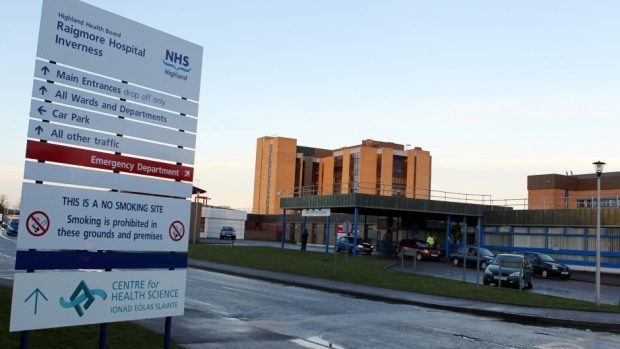Calum Ross
HEALTH chiefs have banned all visitors from the north’s biggest hospital after an outbreak of a highly contagious sickness bug.
Nearly 50 patients in three wards at Raigmore Hospital in Inverness have now contracted norovirus.
Bosses at the hospital announced the suspension of all visiting last night to try to cut the risk of spreading the bug, which causes sickness and diarrhoea.
It is only the second time that the region’s flagship hospital has been closed to all visitors, with the action taken for the first time in April last year after more than 30 people were affected by a similar norovirus outbreak.
The hospital’s ward 2A, which was shut on Wednesday, currently has six patients with symptoms of diarrhoea and vomiting.
It followed the closure of wards 2C and 7C earlier in the week.
Ward 2C currently has 22 patients with the symptoms while Ward 7C currently has 19 affected. Norovirus has been confirmed on both these wards.
Dr Chin Lim, consultant microbiologist for NHS Highland, said the decision to close the hospital to visitors had been taken to try to stop the bug from spreading.
He said: “We have taken the decision today to suspend all visiting at Raigmore Hospital on a temporary basis.
“We currently have a high number of patients in hospital with symptoms of diarrhoea and vomiting and we also know it is found in the community.
“By reducing the amount of traffic coming in to the hospital we hope that will reduce the risk of any further outbreaks of norovirus.”
The only visitors allowed in will be for those in emergency situations, or by arrangement with the nurse in charge.
Iona McGauran, lead nurse for Raigmore Hospital, said: “We have a responsibility to make things safe and we know that norovirus is being brought into the hospital.
“We are asking members of the public not to come in to hospital to visit any ward however, there will be exceptions to that rule, such as an emergency situation, which can be arranged by prior
arrangement with the nurse in charge.
“Hospital staff will of course be very happy to talk to visitors on the phone so they can get updates on how their relatives are.
She added: “We appreciate your understanding for why we have had to take this decision and would like to apologise for any inconvenience caused.”
Raigmore took the then unprecedented move of closing to all visitors for four days in April last year after an outbreak closed four wards.
Commonly known as the “winter vomiting bug”, norovirus is highly contagious and causes vomiting and diarrhoea.
The first sign is usually a sudden sick feeling and symptoms usually last a couple of days, although it can be longer in elderly people.
Hugh Pennington, emeritus professor of bacteriology at Aberdeen University, supported the decision.
“It’s usually a single ward that they close, but they are obviously worried about people bringing it in.
“You would have to say it is a reasonable precaution because the disruption to healthcare is immense when they close a ward, and staff get affected and they are off.
“Clearly some of the patients are vulnerable to quite severe complications from norovirus as well.
If you don’t take it seriously enough you will pay the price. I am very sympathetic to what they are doing.”
Rhoda Grant, Highlands and Islands Labour MSP, also said the hospital had taken the correct decision.
“It’s sensible because they need to take precautions to stop it from progressing,” she said.
“If you are in hospital it can have pretty grim effects on people who are not well anyway, so they need to get it under control.
“My only slight concern is if they have got vulnerable people they allow something, if not visiting, some kind of special support.
“I think folk for their own good should keep away because it is obviously very contagious.”
